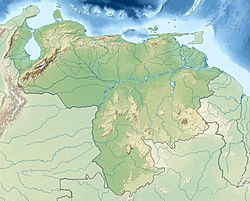Cerro Huachamacari facts for kids
Quick facts for kids Cerro Huachamacari |
|
|---|---|
| Highest point | |
| Elevation | 1,900 m (6,200 ft) |
| Geography | |
| Location | Amazonas, Venezuela |
Cerro Huachamacari is a special kind of mountain called a tepui in Amazonas state, Venezuela. You might also see its name spelled Huachamakari or Kushamakari. It's located to the northwest of a much bigger mountain called Cerro Duida.
Cerro Huachamacari stands about 1,900 meters (or 6,200 feet) tall. Its flat top covers an area of about 8.75 square kilometers (3.38 square miles). The sloped sides of the mountain cover an even larger area, around 60 square kilometers (23 square miles). This unique mountain is part of the Duida-Marahuaca National Park, which helps protect its amazing nature.
Contents
What is a Tepui?
A tepui is like a giant, flat-topped mountain or mesa, often found in the Guiana Highlands of South America, especially in Venezuela. The word "tepui" means "house of the gods" in the native Pemon language. These mountains are very old and are made of sandstone. They often have steep, cliff-like sides and flat tops. Because they are so isolated, many plants and animals found on top of tepuis don't exist anywhere else in the world!
Location and Size of Huachamacari
Cerro Huachamacari is located in the Amazonas state of Venezuela. It's part of a region known for its incredible biodiversity and unique landscapes. While it's not as tall as some other famous tepuis, its height of 1,900 meters still makes it an impressive natural landmark. The mountain's flat summit and steep slopes create a distinct shape that stands out in the surrounding jungle.
Protecting Nature: Duida-Marahuaca National Park
Cerro Huachamacari is inside the Duida-Marahuaca National Park. National parks are special areas created by governments to protect nature, including mountains, forests, rivers, and the animals that live there. This park helps keep Cerro Huachamacari and its unique plants and animals safe for future generations. It's important to protect these places because they are home to many species that can't be found anywhere else on Earth.
See also
 In Spanish: Cerro Huachamacare para niños
In Spanish: Cerro Huachamacare para niños
- Distribution of Heliamphora


